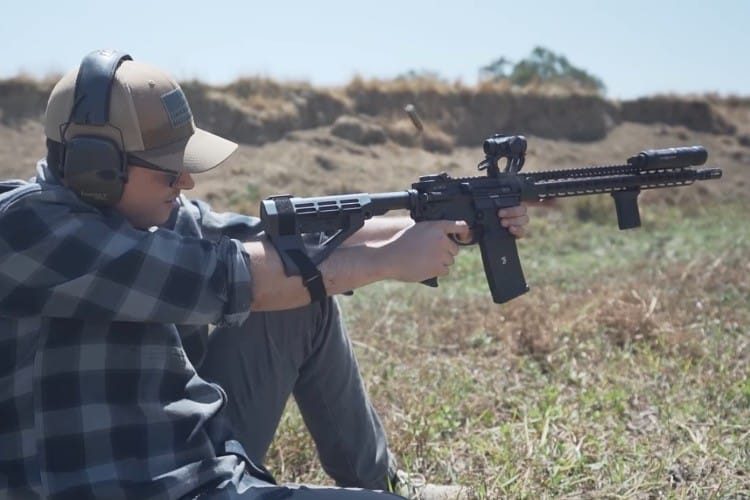
Resistance against the ATF’s pistol stabilizing-brace rule continues to build. On Thursday, attorneys general from 25 states filed a lawsuit claiming that the agency’s new rule is unconstitutional and violates the principle of separation of powers that makes our federal government unique.
The lawsuit opened:
For more than a decade, the Bureau of Alcohol, Tobacco, Firearms and Explosives (“ATF”) authorized the public to use pistol stabilizing braces, a popular firearms accessory, without federal regulation.
During that time, ATF repeatedly issued letter rulings assuring manufacturers and the public that attaching a stabilizing brace would not alter the statutory or regulatory classification of a pistol or other firearm.
As a result, millions of Americans have for years lawfully purchased stabilizing braces and pistols equipped with stabilizing braces from authorized, legitimate manufacturers with ATF’s full knowledge and express approval.
Then the Biden administration intervened:
Then everything changed. Frustrated with congressional inaction, the President of the United States ordered ATF to abandon a decade of practice under an established statutory framework and “to treat pistols modified with stabilizing braces” as “subject to the National Firearms Act.”
This “change,” the President said, would require an owner of a pistol equipped with a stabilizing brace to “pay a $200 fee and submit their name and other identifying information to the Justice Department” or face criminal penalties.
The President’s express aim was to act “without having to go through the Congress.”
This is how things get done in a dictatorship: The ruler makes the rules, decides who violates the rules, and then punishes the violator. With this rule change, Biden is on track.
Continues the lawsuit:
[T]he Rule in effect vests ATF with unbounded discretion.
And ATF has made clear exactly how it intends to exercise that discretion, estimating that, under the Rule, 99% of pistols equipped with stabilizing braces will now be deemed subject to National Firearms Act (“NFA”) controls.
The number of firearms affected by the rule, were it allowed to stand, is between three and seven million according to the ATF. The Congressional Research Service, on the other hand, puts the number between 10 and 40 million. Regardless, the penalties for violating the NFA are harsh, both through fines and potential incarceration.
The lawsuit reviews the hypocrisy and illegal intentions of the ATF:
The Rule … represents an abrupt reversal of ATF’s longstanding position that these items are not subject to NFA controls….
The agency charged with administering the NFA and GCA [Gun Control Act of 1968] believed for years that pistols equipped with stabilizing braces are not subject to heightened regulation and now holds the opposite. [Emphasis in original.]
The states remind the court that President Biden acted as a dictator:
Without any legislative change, the President of the United States ordered ATF to abandon a decade of practice under an established statutory framework and “to treat pistols modified with stabilizing braces” as “subject to the National Firearms Act.”
The lawsuit also reminds the court that what Biden did in ordering the ATF to violate its own rulings in order to promote his anti-gun agenda violated the Second Amendment to the U.S. Constitution:
ATF’s Rule also construes the statute in a way that would raise grave constitutional doubts under the Second Amendment. With millions of stabilizing braces in circulation — even by ATF’s conservative estimate — braced weapons are plainly in “common use” and thus protected by the Second Amendment. (See New York State Rifle & Pistol Ass’n, Inc. v. Bruen)
This is the primary obstacle that lawyers for the Department of Justice will have to overcome in defending this lawsuit. By its own admission, the ATF has clearly and repeatedly stated that pistol braces were in “common use” and thus fall inside the Bruen rule, i.e., the ATF must justify its incursion and infringement of the Second Amendment by demonstrating that it is consistent with the nation’s historical tradition. According to the high court in Bruen, “only then may a court conclude that the individual’s conduct falls outside the Second Amendment’s ‘unqualified command.’”
West Virginia’s Attorney General Patrick Morrisey called out the ATF’s move:
Let’s call this what it is: an effort to undermine Americans’ Second Amendment rights. This is an egregious final rule turning millions of common firearms accessories into “short barreled rifles.” This is a completely nonsensical regulation.
[This is] part of the continued attack by the Biden administration against lawful gun owners.
Morrisey added, “This is also another case of a federal agency not staying in its lane and doing the job the constitution clearly delegates to Congress—writing laws. The Separation of Powers clearly bars federal agencies from making new laws without Congressional directive.”
Indiana Attorney General Todd Rokita backed up Morrisey:
As long as I’m attorney general, we will never willingly cede Hoosiers’ cherished liberties to the whims of federal bureaucrats. This is a clear case of overreach by the executive branch, and we fully expect to prevail in this lawsuit.
By standing together, the individual states can stop the federal government from riding roughshod over our people’s freedoms.
Standing up to tyranny is a time-honored American tradition. It requires us not only to resist broad sweeping power grabs but also to combat the incremental chipping away of rights.
The lawsuit was filed in the U.S. District Court for the Western Division of North Dakota. Readers, as well as lawyers for the DOJ, may expect additional lawsuits to be filed over the matter. In the meantime, it is hoped that one of the courts will issue a temporary restraining order against the ATF’s enforcement of the new rule while the lawsuits are pending.




